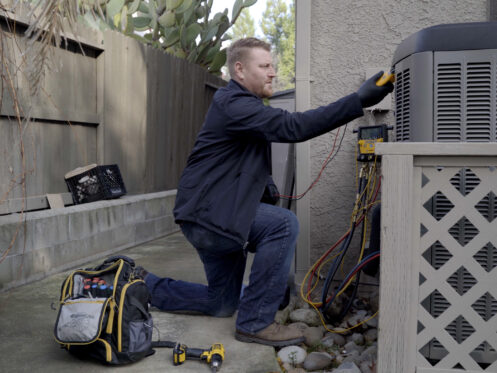Electrification is a process of moving homes and businesses away from fossil fuels in favor of cleaner, more environmentally friendly electric appliances. This strategy is also sometimes referred to as “building decarbonization,” and it is something that is now being pushed heavily by both the US federal government and many states. This is part of their efforts to reduce carbon emissions and fight against climate change. As you might expect, California is at the leading edge of the electrification movement and is encouraging homes and businesses to stop using gas-burning appliances to help meet its goal of making the state completely carbon-neutral by 2045. One of the most important parts of this overall strategy is HVAC electrification, and today we’re going to discuss exactly what this involves and what benefits it can provide.
The Electrification Process and Why It’s Important
The majority of homes in the US have at least one gas-burning appliance. Approximately 60% of American homes have gas water heaters, and nearly one-third of all American households still use gas cook stoves. One part of the electrification process involves switching these units out with more energy-efficient, less polluting options like electric or heat pump water heaters and electric induction stoves.
Where electrification can have a major impact is in moving away from using fossil fuels for heating. Around half of the homes in the US use a gas furnace for heating, and this number is even higher in California where just over 60% of homes have gas furnaces. Using natural gas and other fossil fuels to heat homes is by far one of the biggest sources of both residential energy consumption and carbon emissions. In fact, nearly 40% of the carbon monoxide and other greenhouse gas emissions from residential homes in the US are produced by HVAC systems, and gas and oil furnaces account for a very high percentage of this total.
In terms of central HVAC systems, electrification means switching out your gas furnace for an electric heat pump. You could technically also electrify your HVAC system by switching to an electric furnace, but these units still use a huge amount of energy and really aren’t all that much better than a gas furnace. Heat pumps, on the other hand, are far more energy efficient than any other heating option and can provide many benefits both for your home and the environment.
Lower Energy Bills
One of the biggest benefits of upgrading your home with an electric heat pump is that it can greatly reduce your annual heating costs. Compared to using a gas furnace or electric heating options like baseboard heaters or an electric furnace, a heat pump can lower your energy costs by at least 50%. This number can potentially be even higher in warmer climates like California since the energy efficiency of heat pumps is highest when the outdoor temperature is 40 degrees or above.
The average cost to heat a home with natural gas in California is roughly $450 a year. But this can vary based on different factors such as how large the home is, how energy efficient it is, and how cold the winter is. Nonetheless, switching from a gas furnace to a heat pump will still typically save you a few hundred dollars a year. Considering that heat pumps will typically last for around 15 years, this means you could easily save thousands over the life of the unit.
Reduced Emissions and Smaller Carbon Footprint
On average, an electric heat pump will reduce your home’s carbon emissions by around 45%. A heat pump will still be responsible for some carbon emissions simply because the majority of our electricity is still produced by burning coal and other fossil fuels. However, if your home’s electricity comes mostly from renewable resources like solar or wind power, a heat pump should lower the carbon emissions from heating your home by somewhere around 70-80% compared to using a gas furnace.
Even better is if you have a solar system that is capable of powering your entire home instead of relying on the municipal power grid. In this case, using a heat pump would mean that your home’s heating system was entirely carbon neutral and responsible for zero greenhouse emissions.
Lower HVAC Costs
One great thing about heat pumps is that they can provide both heating and cooling. Heat pumps are quite similar to air conditioners in that they both use refrigerant to absorb heat from one place and transfer it to another. The difference is that heat pumps can change the direction that the refrigerant flows so that they absorb heat energy from the air outside and use this to heat the air inside the home.
Heat pumps are typically slightly more expensive than air conditioners and will usually cost somewhere between a few hundred and a thousand dollars more to purchase and install. However, installing a heat pump should easily save you a few thousand dollars compared to purchasing and installing separate heating and cooling units, such as a furnace and a central air conditioner.
Available Tax Credits and Rebates
Installing a new heat pump in your home may also qualify you for various tax credits and rebates. Many energy companies offer rebates for customers who switch to heating their home with a heat pump as long as the unit was installed by a licensed, certified professional. The 2022 Inflation Reduction Act also established the new Energy Efficient Home Improve Tax Credit program that covers heat pumps and various other home energy-efficiency upgrades.
As part of this new program, homeowners who install a qualifying heat pump anytime between the start of 2023 and the end of 2032 can receive a tax credit worth up to $2,000. This tax credit is capped at 30% of the unit’s purchase and installation cost, which means you may not qualify for the full $2,000 depending on exactly how much the installation costs. Nonetheless, this program will still allow you to save quite a bit of money on your new heat pump as long as it meets certain energy-efficiency requirements. Specifically, the unit must have a cooling efficiency rating of at least 17 SEER2 and a heating efficiency of at least 10 HSPF2, which means that most any ENERGY STAR-rated unit will qualify.
You can also be eligible for the same tax credit for installing certain ENERGY STAR-rated ductless mini-split heat pumps. These units work exactly like a central heat pump except that they don’t use ductwork to move air and instead rely on individual air handler units in each room to heat and cool that space.
The Inflation Reduction Act also set aside $4.4 billion for a separate energy-efficiency rebate program that will be administered by each state. Each state will receive a portion of this total based on its population, and the state will then be responsible for distributing this money to homeowners who make certain energy efficiency improvements. These improvements include upgrading to an electric heat pump. These rebate programs will most likely start in late 2023 or early 2024 and are available to any household whose total annual income is less than 150% of the median income in their area.
Under this rebate program, you can qualify for a rebate of either $4,000 or $8,000 on a new heat pump depending on your income level. There are also no energy-efficiency requirements for this rebate program, which means that any new heat pump will automatically qualify.
Expert HVAC Services
If you’re looking to electrify your home, Environmental Heating & Air Solutions is here to help. We carry a wide selection of heat pumps and ductless mini-split systems, and our team of professional plumbers can also help if you’re looking to upgrade to an electric water heater or hybrid heat pump water heater. For more information on the benefits of home electrification or to schedule any heating, cooling, or plumbing service in the Roseville or Benicia areas, contact us today.

